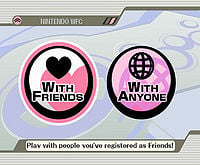| Welcome to SmashWiki! Log in or create an account and join the community, and don't forget to read this first! |
| Notices |
|---|
| The Skill parameter has been removed from Smasher infoboxes, and in its place are the new "Best historical ranking" and "Best tournament result" parameters. SmashWiki needs help adding these new parameters to Smasher infoboxes, refer to the guidelines here for what should be included in these new parameters. |
| When adding results to Smasher pages, include each tournament's entrant number in addition to the player's placement, and use the {{Trn}} template with the matching game specified. Please also fix old results on Smasher pages that do not abide to this standard. Refer to our Smasher article guidelines to see how results tables should be formatted. |
| Check out our project page for ongoing projects that SmashWiki needs help with. |
Nintendo Wi-Fi Connection: Difference between revisions
No edit summary |
No edit summary Tag: Mobile edit |
||
| Line 1: | Line 1: | ||
{{ArticleIcons|ssbb=y}} | {{ArticleIcons|ssbb=y}} | ||
'''Nintendo Wi-Fi Connection''', or '''WFC''', was a service from [[Nintendo]] that allowed Nintendo [[Wii]] and [[Nintendo DS]] games and applications to connect to the Internet. ''[[Super Smash Bros. Brawl]]'' was one of the many games that had compatibility with the service, using it to allow for online brawls [[ | '''Nintendo Wi-Fi Connection''', or '''WFC''', was a service from [[Nintendo]] that allowed Nintendo [[Wii]] and [[Nintendo DS]] games and applications to connect to the Internet. ''[[Super Smash Bros. Brawl]]'' was one of the many games that had compatibility with the service, using it to allow for online brawls [[with friends]] or [[with anyone]]; in addition, players could also exchange some data with each other with the service. | ||
The service was later superseded by the [[Nintendo Network]] for the [[Wii U]] and [[3DS]], though the Nintendo Wi-Fi Connection continued to act as a legacy connection for the Wii and DS consoles; both the Wii U and 3DS had only limited compatibility with the service. | The service was later superseded by the [[Nintendo Network]] for the [[Wii U]] and [[3DS]], though the Nintendo Wi-Fi Connection continued to act as a legacy connection for the Wii and DS consoles; both the Wii U and 3DS had only limited compatibility with the service. | ||
With the shutdown of the service's network provider | With the shutdown of the service's network provider [[wikipedia:GameSpy|GameSpy]] in May 2014, the service was taken offline on 20 May 2014. Hacks, however, have been developed to allow players to continue playing compatible games via private servers. | ||
==In ''Brawl'' == | ==In ''Brawl'' == | ||
Revision as of 22:38, October 15, 2014
Nintendo Wi-Fi Connection, or WFC, was a service from Nintendo that allowed Nintendo Wii and Nintendo DS games and applications to connect to the Internet. Super Smash Bros. Brawl was one of the many games that had compatibility with the service, using it to allow for online brawls with friends or with anyone; in addition, players could also exchange some data with each other with the service.
The service was later superseded by the Nintendo Network for the Wii U and 3DS, though the Nintendo Wi-Fi Connection continued to act as a legacy connection for the Wii and DS consoles; both the Wii U and 3DS had only limited compatibility with the service.
With the shutdown of the service's network provider GameSpy in May 2014, the service was taken offline on 20 May 2014. Hacks, however, have been developed to allow players to continue playing compatible games via private servers.
In Brawl
The Nintendo Wi-Fi Connection allowed players to play against each other online for the first time in the series. A primary point of this was that it allowed players to either play with anyone in the world or with registered friends. The former, With Anyone, allowed players to either take part in standard free-for-all battles via Basic Brawl, or to play as a part of a team in Team Battle.
In addition to allowing for online gaming, Brawl also allowed players to send replays, custom stages, and snapshots to other players with whom they had registered. An applied use of this was the Smash Service, a free service that sent players a replay, a custom stage, and a snapshot each day; these pieces of data came from submissions of players, and were deleted at the end of the day.
External links
| hide Super Smash Bros. Brawl menu items | |
|---|---|
| Group | Brawl (Time · Stock · Coin Battle · Team Battle) · Rules · Special Brawl · Rotation · Tourney · Names |
| Solo | Classic · All-Star · Adventure Mode: The Subspace Emissary · Events · Stadium (Target Smash!! · Home-Run Contest · Multi-Man Brawl · Boss Battles) · Training |
| Wi-Fi | Spectator Mode · With Anyone · With Friends |
| Vault | Trophies & Stickers (Trophy Gallery · Trophy Hoard · Coin Launcher · Sticker Album · Sticker Center) · Stage Builder · Album · Challenges · Replays · Masterpieces · Chronicle |
| Options | Screen · Deflicker · Rumble · Controls · Sound · My Music · Erase Data |
| Data | Movies · Records (Group Records · Brawl Records · Notices) · Sound Test |

